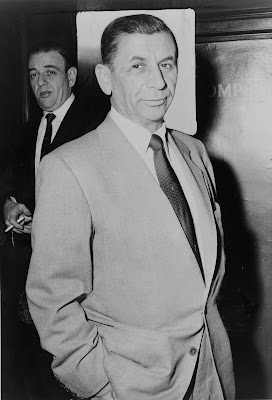Cuba, Once the Mafia's New Frontier
In 2003, New York-based Bonanno
 crime family members called Montreal Mafia boss Vito Rizzuto and told him the worst possible news.
crime family members called Montreal Mafia boss Vito Rizzuto and told him the worst possible news.The Bonanno crime family's boss, Joseph Massino
 , had flipped, they told Rizzuto.
, had flipped, they told Rizzuto.Rizzuto faced serious trouble. Massino could implicate him in a triple homicide in New York City, in 1981. Massino had actually orchestrated the hit on three dissident Bonanno capos.
Alerted to a pending arrest for three homicides, Rizzuto and his wife promptly flew to Cuba, taking a flight the very next day to the Melia Las Americas, a resort in Varadero, Cuba.
There, the Rizzutos bided time in the five-star resort's tropical-style rooms, each of which offers a beach-side view via a balcony; they could dine in any one of its seven restaurants (ranging from casual, poolside snacks to fine dining), as well as pay a visit to the hotel's three bars and one nightclub.
 |
| Meyer Lansky represented the mob in Cuba. Santo Trafficante Jr. hated him. |
"Vito went there to assess his options," said a retired Montreal Mafia investigator.
According to Lee Lamothe and Adrian Humphreys' The Sixth Family, Rizzuto was known to have financial interests in the small island nation. He and his men and their families participated in extended stays there under Castro's Communist flag.
Now that Fidel Castro is dead, some may speculate about the Mafia's return to Cuba. But the truth is, the mob won't return to Cuba.
The Mafia has already returned to Cuba.
Varadero
Rizzuto stayed in Varadero, a resort town in Cuba's Matanzas province, where many of Havana’s most spectacular hotels were constructed in the 1950s. They originally were equipped with casinos and were funded by American mobsters who profited from them until Fidel Castro came to power.In 1955, Cuba's tourist economy was booming to such an extent that it was quickly noticed that there was a need for more high-class hotels. The American Mafia, which had already laid the groundwork to launch Cuban endeavors and which had been using the island as a smuggling point since the 1920s, if not earlier, were soon summoned by Cuban President Fulgencio Batista's lax Cuban gambling laws as well as the passage of Hotel Law 2074. This law codified tax exemptions for those who built hotels designed to accommodate tourists. The law added certain perks to those who met certain requirements: Anyone who invested $1 million or more in hotel construction (or $200,000 in the construction of nightclubs) was to benefit from the law's main provisos: government financing and a gaming license, no questions asked.
By 1956, Havana had attracted many of America’s professional casino operators, who by then were established in Las Vegas. Most of them went to Cuba to do business, with Lansky’s blessing. (Not Lansky so much as the powers he represented.)
One of the more powerful mobsters to head to Cuba was Moe Dalitz; he and his partners had purchased part of the Nacional casino. The plan was for them to take it over completely after Lansky's Riviera Hotel opened.
Moe Dalitz
Shortly after Bugsy Siegel was killed, Morris Barney Dalitz arrived in Las Vegas.
Morris, who initially followed his father into the family business, had opened a string of laundries in Michigan, then branched out to Cleveland in the 1930s.
Morris Dalitz quickly seized opportunities to enter the booming bootleg business, using his laundry trucks to ferry hooch. "Not only could you get your shirts cleaned and delivered, but between the folds you would find your Scotch."
 |
| Moe Dalitz |
Additionally, Dalitz formed alliances that lead to the creation of a large and powerful organized crime operation that ran Cleveland. Dalitz had first cultivated strong ties within Cleveland’s Little Italy community. He then merged his group with other crime rings in the area, including the syndicates based in Murray Hill and the Mayfield Road area. This brought into his realm such mobsters as Fred “Freddy King” and John “Johnny King” Angersola, who were brothers; Alfred “The Owl” Polizzi; and Frank and Anthony Milano, also brothers, who were part of the “Mayfield Road Mob” to form the leading underworld organization in Cleveland.
Milano was the official Cleveland crime family boss. By 1932, he's alleged to have risen to become one of the top bosses in the country. Milano eventually gained a seat on the Mafia's board of directors, aka the National Commission (also the brainchild of Charlie Luciano -- and, again, to a debatable extent, Meyer Lansky) created in 1931.
Morris became known as Moe.
Havana Mob
The Havana Mob, as TJ English called them in Havana NocturneThe Hotel Deauville was built in 1957 by Santo Trafficante Jr., the Florida crime boss whose father was among the first mobsters to commence operations in Cuba, prior even to Meyer Lansky. Speaking of Lansky, his luxurious Hotel Riviera opened in late 1957. Lanksy was the true force behind it, having conceived and funded it. He also was behind the Capri, which opened the same year as the Riviera. Hollywood legend George Raft was hired to meet and greet guests.
"The Havana Riviera was Meyer’s own baby," noted Robert Lacey in his seminal Lansky bio, Little Man-Meyer Lansky and the Gangster Life
 |
Meyer’s name appeared on the paperwork as director of the hotel’s kitchens. This is how Lansky always operated -- in the shadows. Also, since he was -- nominally -- only an employee of the hotel, this helped him financially: He made annual declarations of his Havana income to the IRS, but paid much less tax as an employee than as an owner.
We will continue with the Havana Conference of 1946
Comments
Post a Comment